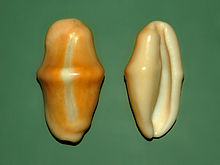- Flamingo tongue snail
-
Flamingo tongue snail 
Cyphoma gibbosum feeding on a soft coral. The animal's siphon is visible at the top, the tip of the tail is visible at the bottom. A large feeding scar is visible as a brown stripe on the coral. Scientific classification Kingdom: Animalia Phylum: Mollusca Class: Gastropoda (unranked): clade Caenogastropoda
clade Hypsogastropoda
clade LittorinimorphaSuperfamily: Cypraeoidea Family: Ovulidae Subfamily: Ovulinae Tribe: Ovulini Genus: Cyphoma Species: C. gibbosum Binomial name Cyphoma gibbosum
(Linnaeus, 1758)Synonyms[1] - Bulla gibbosa Linnaeus, 1758
- Cyphoma dorsata Röding, 1798
- Cyphoma gibbosa (Linnaeus, 1758) (error in gender ending)
- Cyphoma precursor Dall, 1897
- Ovula pharetra Perry, 1811
The flamingo tongue snail, scientific name Cyphoma gibbosum, is a species of small but brightly-colored sea snail, a marine gastropod mollusk in the family Ovulidae, the cowry allies. Although the live animal is brightly colored, that color is only in the soft parts; the shell itself is plain white.
Contents
Distribution
This Cyphoma is distributed in the Mid-Atlantic Ridge. It is the most common of several species in the genus which live in the tropical waters of the Western Atlantic Ocean, including the Caribbean Sea, the Gulf of Mexico and the Lesser Antilles. It can also be found from North Carolina, the Bermudas to Northern Brazil.
Shell description
A shell of Cyphoma gibbosum, dorsal and ventral view
The shells of these quite common species reach on average 25–35 millimetres (0.98–1.4 in) of length, with a minimum size of 18 millimetres (0.71 in) and a maximum shell length of 44 millimetres (1.7 in). .[2]
The shape is usually elongated and the dorsum shows a thick trasversal ridge. The dorsum surface is smooth and sparkly and may be white or orange, with no markings at all except a longitudinal white or cream band. The base and the interior of Cyphoma gibbosum shell is white or pinkish, with a wide aperture. These shells vaguely resemble the shells of cowries.
Description of the live animal
When it is alive, the snail appears bright orange-yellow in color with black markings. However, these colors are not in the shell, but are only due to live mantle tissue which usually cover the shell. The mantle flaps can be retracted, exposing the shell, but this usually happens only when the animal is attacked.
Ecology
Minimum recorded depth is 0 m.[2] Maximum recorded depth is 29 m.[2]
The flamingo feeds by browsing on the living tissues of the soft corals on which it lives. Common prey include Briareum spp., Gorgonia spp., Plexaura spp., and Plexaurella spp. Adult female C. gibbosum attach eggs to coral which they have recently fed upon. After roughly a week and a half, the larvae hatch. They are planktonic and eventually settle onto other gorgonian corals. Juveniles tend to remain on the underside of coral branches while adults are far more visible and mobile. Adults scrape the polyps off the coral with their radula, leaving an easily visible feeding scar on the coral. However, the corals can regrow the polyps, and therefore predation by C. gibbosum is generally not lethal.
Survival status
This species used to be common, but it has become rather uncommon because of over-collecting by snorkelers and scuba divers, who make the mistake of thinking that the color is the shell of the animal.
References
- ^ WoRMS (2009). Cyphoma gibbosa (Linnaeus, 1758). Accessed through: World Register of Marine Species at http://www.marinespecies.org/aphia.php?p=taxdetails&id=419727 on 2010-05-24
- ^ a b c Welch J. J. (2010). "The “Island Rule” and Deep-Sea Gastropods: Re-Examining the Evidence". PLoS ONE 5(1): e8776. doi:10.1371/journal.pone.0008776.
Further reading
- Burkepile D. E. & Hay M. E. (2007). "Predator release of the gastropod Cyphoma gibbosum increases predation on gorgonian corals". Oecologia 154(1): 167–173. doi:10.1007/s00442-007-0801-4
- Whalen K. E., Lane A. L., Kubanek J., Hahn M. E. (2010). "Biochemical Warfare on the Reef: The Role of Glutathione Transferases in Consumer Tolerance of Dietary Prostaglandins". PLoS ONE 5(1): e8537. doi:10.1371/journal.pone.0008537
External links
Categories:
Wikimedia Foundation. 2010.


